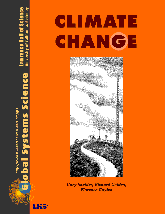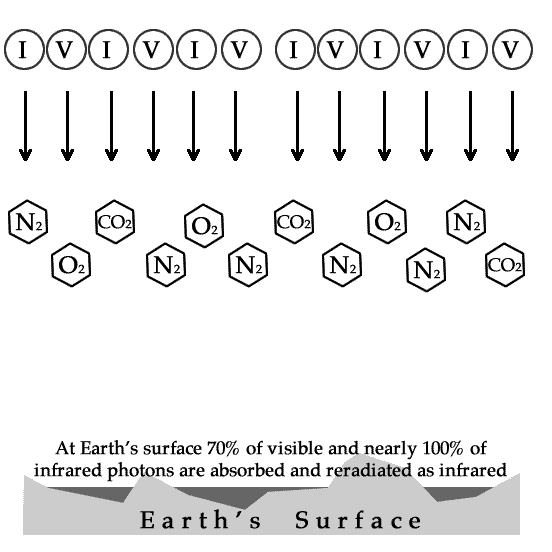CC1.1. Light in the Atmosphere

{ Climate Change Contents } { All GSS Books }
In this model (game), half the students act as photons and half as molecules. The model can be done either as a board game with students working in groups and moving pieces across a board, or as a whole class model where each student acts as a photon or molecule. Students acting as photons move across the room and students that act as molecules represent the atmosphere in the model.

The “V” and “I” are the photon students holding colored paper: one side yellow for “Visible” photons and the other side red for “Infrared” photons, all coming from the Sun. The sheets are folded in half, so they can convert from Visible to Infrared if absorbed and reradiated at the Earth’s surface or by CO2 molecule.
The N2 & O2 students always let both visible and infrared photons pass through. The CO2 students will flip a “coin” and if heads, photon continues in same direction and if tails, photon reverses direction. This symbolizes reality in which photon is absorbed and reradiated in random direction, half toward Earth and half toward space.
As a board game, students in each group playing the game divide up the photons and molecules depending on number of students in each group.
Rules of the Light-In-Air Game (Model):
1. Set up: Photons line up alternating I and V.
Air Molecules line up, not quite in line,
but in more or less random arrangement in
terms of types of molecules.
2. Photons move towards air molecules,
1 photon for each molecule.
3. All photons wait to receive instructions from molecules.
a. CO2 molecules instruct photon to become infrared and flip
coin to determine whether they proceed onward
or turn back toward space.
b. N2 and CO2 instruct photon to
proceed in same direction unchanged.
4. Photons move toward Earth or space
in accord with instruction from molecule from step 3.
5. Photons moving toward space stay in space.
Photons striking Earth all are absorbed and
reradiate as I (infrared) back to the atmosphere,
EXCEPT 1/3 of the Vs are chosen to
remain as V (they are reflected).
6. Repeat step 3: photons receive instructions from molecules,
but this time photons are coming from Earth’s surface.
7. Count how many photons are in space and
how many are trapped on Earth (or in atmosphere).
Record these numbers.
Repeat this game with
- 80% N2 and 20% O2 (no CO2), e.g. 12 N2 and 3 O2 if there are 30 players/students.
- A modest amount of CO2, e.g. 10 N2, 2 O2, and 3 CO2.
- About half CO2, e.g. 7 CO2, 6 N2, and 2 O2.
- All CO2 (Venus).

